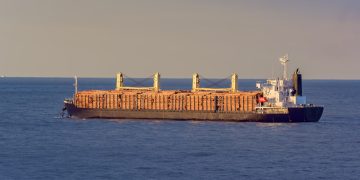The following real-life incident can be used as case study to help crew members understand how to properly handle similar occasions and take the appropriate knowledge from an incident of fire on board cargo vessel.
The incident
A bulk carrier was on voyage between 2 ports in Europe. During her passage, vessel’s crew was operating cleaning procedures in Cargo holds and A/E No.1 and No.2 were on parallel function as the ship was needed a larger electrical load than it usually requires.
Engine crew was carrying out a renewal of lube oil filters, while engine officers were participating in a safety meeting conducted at the engine control room. As a result, engine ratings had been carrying out their tasks without the supervision of engineer officers. Suddenly, engine ratings observed flames between the two running generators. Fire alarm sounded in order to inform the rest crew members. Officers communicated with the bridge to make sure that they can stop engines, then they tripped the main supply bakers on the switch board and the emergency generator came on load. In a few minutes, the engine room had been covered with black smoke and it was difficult for the crew to breathe or see clearly, thus they evacuated machinery space immediately. Aiming to isolate the engine room in order not to let the fire spread, the crew operated the ventilation trips, flaps and the quick closing valves.
Subsequently, on board fire team entered the engine space totally equipped, wearing self-contained breathing apparatus (SCBA) and with portable and semi-portable extinguishers, managed to fully extinguish the fire. For a few hours, they continued to check machinery space for portable fire outbreaks, and by the time they ensured safety, they re-entered the room. Appropriate safety checks concerning the continuance of operations had been taking place to set A/E No. 3, the main engine and other machinery in operation mode, in order to resume passage.
Actions Taken
- Vessel’s crew immediately informed the office, which had been kept updated during the whole procedures, giving the appropriate guidelines and advice when needed.
- Company’s designated persons immediately contacted the Class Society in order to be informed about the fire on board and an inspection was requested when vessel would approach the next port
- Company’s designated persons informed the P&I club and H&M underwriters about the incident.
Probable Cause
Incident investigation indicated the following causes that may led to the fire in engine room:
- On A/E No. 2, one of the three bolts that secure lubricating oil filter had displaced the cover, leading the lube oil to splash onto various hot components on both generators, which finally ignited.
- All the lube oil had been spilled in the tank of the A/E No. 2, because lube oil primer pumps had continued to operate after engine’s shutdown, gathering power by emergency power source. A/E No. 2 was the main source which fed the fire.
- It is common filter cover bolts to be too wear or too loose as a result of continuous vibration or due to the internal pressure from pumps. That fact makes the regular inspection routines a necessity, as in this case these fittings were improperly tightened and engine room supervision was inadequate.
- It was also observed that the cover bolts used on lube oil pipes and filters on A/E were not properly manufactured with the full absence of extra securing arrangements or spray shields.
Corrective/ Preventive actions
- Safety meeting conducted on board to review results in order to plan actions and avoid reoccurrence. Moreover, fleet circular has been issued to highlight the importance of item.
- Cover bolds and protective fittings for lube oil pipes and filters of engines replaced the old ones in order to adopt to extra securing arrangements.
- Filter cover bolts and all the fittings of engine generators will be inspected periodically in order to be maintained according to the safety procedures that should be followed on board vessel.
- A/E been restored to be functional and several checks by the engineers took place in order to make sure that it is in a good working condition.
- Vessel’s crew immediately fixed the damages occurred, cleaned and maintained engine room and also restored the vessel areas affected by the fire.
Lessons Learned
Preventing hazard is preferable than having to face its impacts. However, such incidents are inevitable to be occurred and this is an opportunity to learn from the past to improve safety performance.
Similar cases and incidents should be reported and incorporated in shipping companies drill programs and risk assessments as well, always in line with the SMS. Discussions about the incident should always take place to increase awareness. More specifically, it is important to bear in mind that:
- Supervision and delegation of tasks is an important part of onboard operations. Critical activities that hide risks should always be supervised and before each task, a risk assessment should be conducted.
- Fire drills should be held as soon as practical after leaving port (in case of 25% of crew has been changed or has not participated in the previous month) and in line with Flag Administration Requirements. A simulated fire (class A, B, C*) should be drilled in a different part of the ship and the crew should be trained in the use of portable and fixed fire-fighting equipment. Exercise all crew in wearing and using of fireman outfit and relevant breathing apparatus equipment.
- Crewmembers should be familiarized with combustible oil and its products in order to understand its nature and what makes them flammable. Awareness would help them handle flammable oil accordingly and be more careful every time they spot an oil leakage.
- Maintain engine room areas and keep bilges clean and free of oil. Cleanliness of engine room is not only a matter of good appearance, it is also imperative for safety reasons.

































































